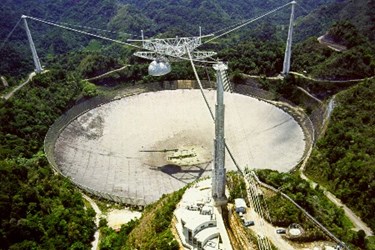Arecibo Observatory 'Still Standing' After Hurricane Maria, But Future Remains Clouded
By Jof Enriquez,
Follow me on Twitter @jofenriq

Hurricane Maria, a Category 4 storm (on landfall) that was the strongest to hit Puerto Rico in 90 years, inflicted less damage to Arecibo Observatory than earlier reported. Repair costs, however, are expected to complicate the radio telescope's already precarious source of funding, raising further doubt about the future of the historic facility.
“Despite the initial reports of significant damage, it turns out the damage is not anywhere near as serious as we thought,” said Ralphe Gaume, deputy division director for the National Science Foundation (NSF) Division for Astronomical Sciences, according to Space News.
The instruments confirmed damaged include a 30-meter (98.5-foot) suspended "line feed" antenna for one of the radar systems, which was operated at a frequency of 430 megahertz and used for atmospheric studies. It fell down and damaged 30 panels out of the 40,000 panels that make up the main dish of the 305-meter (1,000-foot) radio telescope.
A secondary 12-meter (40-foot) dish used for Very Long Baseline Array (VLBA) studies was found to have sustained minimal damage, contrary to initial reports suggesting it was destroyed.
“As a result of the relatively intact Arecibo Observatory infrastructure, the Observatory is currently being used as a search and rescue hub by FEMA. At this time, we cannot predict when research operations at Arecibo Observatory might resume, however test observations to evaluate performance have begun,” said NSF Acting Assistant Director Jim Ulvestad.
Amid the ongoing humanitarian crisis in Puerto Rico following Hurricane Maria, Arecibo's staff, who hunkered down as the storm pummeled the island, posted a message on Facebook saying they and the facility are “still standing.”
“All the staff and their families that sheltered at the observatory are safe,” said Nicholas White, senior VP of Universities Space Research Association (USRA), which helps run the observatory, reported Sky and Telescope. “We have contact with most staff who were offsite, though a few still remain to check in — given the difficulties with communications on the island, this is most likely the reason.”
Arecibo Observatory — which was surpassed last year by China's Five-hundred-meter Aperture Spherical Telescope (FAST) as the world’s largest single-dish radio telescope — has a well-earned reputation in astronomical research since it opened in 1963. Its list of accomplishments include being the first to find the first planets orbiting other stars, the first to image near-Earth asteroids, the first to find a binary pulsar, and more recently, capturing fast radio bursts. It is best known to the public as part of the Search for Extra-Terrestrial Intelligence (SETI) program.
NSF Acting Director Jim Ulvestad told NPR that Arecibo is doing "excellent science" but "if you look at the overall sweep of things that we're funding, we do have to make choices and we can't keep funding everything that's excellent."
According to Space News, NSF wants to taper its spending on Arecibo to $2 million annually over the next five years, and has solicited for private entities to take over much of the agency's share in the facility's costs, which run up to $8 million annually.
NSF's preferred plan was among those considered in a final environmental impact statement released Aug. 4, which also discussed other options, including divestment, closure, and demolition of the facility, reported Space News.
Due to delays brought about by the impact of Hurricane Maria, the agency is expected to come up with a final “record of decision” sometime in the fall.
